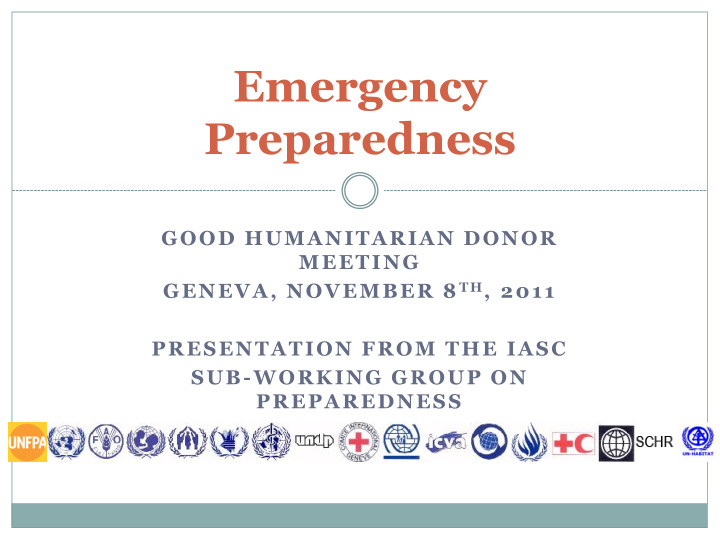



Emergency Preparedness GOOD HUMANITARIAN DONOR MEETING GENEVA, NOVEMBER 8 TH , 2011 PRESENTATION FROM THE IASC SUB-WORKING GROUP ON PREPAREDNESS
Background GA resolution 46/182: “Affected state has primary role in initiation, coordination and implementation of humanitarian assistance within its territory” ECOSOC resolutions on need to increase efforts to develop national emergency preparedness capacities IASC Principals discussions include a theme on Developing National Capacity for Preparedness
Components of Emergency Preparedness Institutional and Hazard/Risk Legislative Coordination Analysis & Early Frameworks warning Resource Contingency/ Allocation and Preparedness and Emergency Funding Response Planning Preparedness Emergency Training and Services/Standby Exercises Arrangements/Pre Information positioning Management and Communication
Multi-Hazard Emergency Preparedness Geo-seismic Biological Emergency Preparedness Conflict Hydro- meteorological Technological Others
Single-Hazard Contingency Planning Emergency Preparedness Conflict
Emergency Preparedness in Emergency Risk Management Multi-Hazard Preparedness Prevention and Mitigation Early- Warning Recovery EMERGENCY PREPAREDNESS Preparedness for Response Emergency Response
Emergency Preparedness and the Hyogo Framework of Action Priority 1 Priority 2 DRR is a Identify, national & assess & local priority monitor disaster risks, Priority 3 enhance early- Use warning knowledge, Emergency innovation & Preparedness education to build a culture Priority 5 of safety Strengthening disaster Priority 4 preparedness Reduce for effective underlying response risk factors
Emergency Preparedness and Climate Change Adaptation Climate Change Adaptation Emergency Preparedness
WHOSE CAPACITY FOR EMERGENCY PREPAREDNESS National/ Relevant Line Sub-National Ministries at Disaster Regional National and Management Bodies Sub-National Authorities Level including Civil Protection Civil Society including IASC National and Agencies Local NGOs Private Sector Communities
Key definitions • Different definitions used but many agencies are either adopting or adapting ISDR terminology • Commonalities in different definition • Developing Capacity: resources, systems, attributes • Global, Regional, National, Local • Anticipate, Respond and Recover from disasters/emergencies
Summary of IASC emergency preparedness activities at all levels (based on survey) Components Global Regional National Local/Sub-national Institutional and FAO, ISDR, CARE, WHO UNDP, ISDR, WHO OCHA, UNDP, WHO UNDP legislative frameworks Coordination OCHA, UNDP, WHO, WFP, OCHA, OHCHR, WHO, OCHA, UNDP, OHCHR, OHCHR, WFP, ISDR UNICEF, ISDR, SC WFP, UNICEF, ISDR WFP, UNICEF, ISDR, LWR, SC,WHO Hazard/risk analysis and OCHA, UNDP, OHCHR, OCHA, WFP, UNICEF, UNDP, UNICEF, FAO, UNDP, UNICEF, LWR, SC early warning WFP, UNICEF, FAO, WHO, WHO, WVI, LWR, SC WHO, WVI, WFP CARE Contingency & OCHA, OHCHR, WFP, OCHA, UNDP, OHCHR, OCHA, UNDP, OHCHR, UNDP, OHCHR, WFP, preparedness and UNICEF, WHO WFP, UNICEF, WHO, WFP, UNICEF, WHO, SC, UNICEF, ISDR, WVI, SC response planning ISDR, IOM, CARE, SC ISDR, IOM, CARE, WVI, Training and exercises OCHA, UNDP, CADRI, OCHA, UNDP, CADRI, OCHA, UNDP, CADRI, UNDP, OHCHR, WFP, OHCHR, WFP, UNICEF, OHCHR, UNICEF, WHO, OHCHR, WFP, UNICEF, FAO, WHO, ISDR. IOM, WHO, IOM, CARE, WVI, ISDR, IOM, WVI, LWR, SC FAO, WHO, ISDR, IOM, WVI, LWR, SC ECB, SC CARE, ECB, SC Information management OCHA, WFP, UNICEF, FAO, OCHA, WFP, FAO, WHO OCHA, WHO, UNICEF, - and communication ISDR, CARE, WHO FAO, ECB , WFP Emergency services/ OCHA, UNDP, OHCHR, OCHA, OHCHR, WFP, OCHA, OHCHR, WFP, UNDP, WFP, UNICEF, standby operations/pre- WFP, UNICEF, WHO, IOM, UNICEF, WHO, CARE, UNICEF, WHO, CARE, CARE positionning CARE, WVI, ECB, IRC, SC WVI, SC WVI, SC Incorporating early UNDP, UNICEF, CARE OCHA, WFP UNDP, UNICEF, WHO, - recovery into WFP preparedness planning Resource allocation and OCHA, UNDP, OHCHR, OCHA, WHO, WVI, WFP OCHA, UNICEF, WVI, WVI funding WHO, UNICEF, ISDR, WHO CARE, WVI, IRC, SC, WFP
Main Gaps resulting from Survey • Deficiencies in coordination and standards in Inter Agency preparedness • Lack of predictable, systematic, coordinated and coherent approach to capacity development of national/local actors on emergency preparedness • Insufficient funding for emergency preparedness for agencies and inter-agency as well as for capacity development of national/local actors • Emergency preparedness seen as a humanitarian endeavour, not sufficiently linked to development work
The SWG – Context & Trends Minimum measures & realistic focus Coherence with national capability and response Resource reality - GFC et al
The SWG – What We Do Produce early warning Advocate early action Produce tools for coherent preparedness action Planning Tracking preparedness and readiness action Simulation Help facilitate focused, practical, coherent action Network of operational “good practice” expertise Linkages – e.g. CADRI Linkages – Resource Partners
The SWG and You – Where we are Moving Why? Vision without support and resources = hallucination Building awareness Breaking the humanitarian – development firewall Transforming awareness to action: Moving to focused practical coherent action Political support Financial support In kind support
Key Takeaways
Thank You
Recommend
More recommend